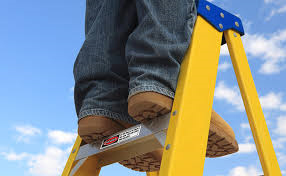
OSHA Not Kidding Around When it Comes to Ladder Safety.
- Category: Blog

OSHA spells it out pretty clearly: “Working on and around stairways and ladders is hazardous. Stairways and ladders are major sources of injuries and fatalities among construction workers. Many of the injuries are serious enough to require time off the job. OSHA rules apply to all stairways and ladders used in construction, alteration, repair, painting, decorating and demolition of worksites covered by OSHA’s construction safety and health standards.”
It doesn’t take a brain surgeon to know that by their very nature ladders are inherently dangerous, especially when used incorrectly. And as a result, OSHA has specific rules about using ladders and working near ladders, as well as how ladders should be designed.
In general, there are three categories of ladders used in the workplace:
1. Stepladders
2. Portable ladders, including self-supporting (foldout) ladders and non-self-supporting (leaning) ladders
3. Fixed ladders
OSHA has general rules governing the use of these ladders, as well as specific regulations for each kind of ladder. Rules cover issues such as the following:
- how much weight a ladder can bear
- the angle and position of a ladder
- the spacing and design of ladder rungs, cleats, or steps
- how to use two or more ladders together to achieve additional height
- ladder care and maintenance
Why OSHA Ladder Safety Violations Happen
Understandably, the majority of ladder-related injuries and deaths are a result of falls. Perhaps an electrician standing on a ladder to install ballast slips on a wet rung of a fixed ladder, or he erroneously stands on the top rung of a step ladder and loses his balance. According to OSHA, accidents like these are totally avoidable, as are the fines that will surely follow.
In fact, many OSHA violations related to ladders can be narrowed down to two categories: misuse and mis-measurement. Oftentimes, it’s unintentional. Other times, it’s willful—such as a worker or supervisor choosing to ignore basic safety precautions because they’re in a rush or believe the rules are unnecessary. Speed rarely often equals safety.
One of the most common issues is side rail height. Keep in mind that when a portable ladder is used to access an area out of reach, the side rails must extend at least three feet above the upper landing surface, allowing for the worker’s weight to step off safely. Too often, a worker or supervisor will overlook this rule because the ladder seems tall enough to provide access—regardless of whether the side rails reach three feet.
Another common violation is using the top of a stepladder as a step. No worker should ever sit, stand, or climb on the top platform of a stepladder.
Violations also happen when workers use ladders for unintended purposes, such as scaffolding, bracing, or as a work platform. Statistics show that the best item to use for scaffolding is… scaffolding.
Finally, many violations involve the use of ladders with structural defects. It is unwise to use a bent, rusty, or broken ladder. Workers (especially electricians) should also never use a ladder built without proper support or grips, or any ladder that is wet, oily, or greasy. When it comes to proper ladder use on the job; common sense rules the day.
Taking the time to inspect ladders for defects and replace them if needed, or ensuring you have the correct ladder for the job, is time and money well spent.


